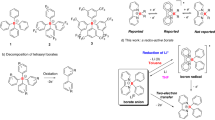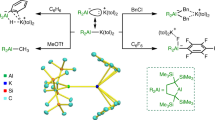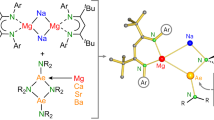Abstract
The search for receptors that can selectively capture small and potentially toxic anions in protic media has sparked a renewed interest in the synthesis and anion-binding properties of polydentate Lewis acids. Seeking new paradigms to enhance the anion affinities of such systems, we synthesized a bidentate Lewis acid that contains a boryl and a telluronium moiety as Lewis acidic sites. Anion-complexation studies indicate that this telluronium borane displays a high affinity for fluoride in methanol. Structural and computational studies show that the unusual fluoride affinity of this bidentate telluronium borane can be correlated with the formation of a B–F → Te chelate motif supported by a strong lone-pair(F) → σ*(Te–C) donor–acceptor interaction. These results, which illustrate the viability of heavier chalcogenium centres as anion-binding sites, allow us to introduce a novel strategy for the design of polydentate Lewis acids with enhanced anion affinities.
This is a preview of subscription content, access via your institution
Access options
Subscribe to this journal
Receive 12 print issues and online access
$259.00 per year
only $21.58 per issue
Buy this article
- Purchase on Springer Link
- Instant access to full article PDF
Prices may be subject to local taxes which are calculated during checkout






Similar content being viewed by others
References
Wuest, J. D. Multiple coordination and activation of Lewis bases by multidentate Lewis acids. Acc. Chem. Res. 32, 81–89 (1999).
Wedge, T. J. & Hawthorne, M. F. Multidentate carborane-containing Lewis acids and their chemistry: mercuracarborands. Coord. Chem. Rev. 240, 111–128 (2003).
Shur, V. B. & Tikhonova, I. A. Perfluorinated polymercuramacrocycles as anticrowns. Applications in catalysis. Russ. Chem. Bull. 52, 2539–2554 (2003).
Taylor, T. J., Burress, C. N. & Gabbaï, F. P. Lewis acidic behavior of fluorinated organomercurials. Organometallics 26, 5252–5263 (2007).
Kilyanek, S. M., Fang, X. & Jordan, R. F. Synthesis and reactivity of a tetragallium macrocycle. Organometallics 28, 300–305 (2009).
Hudnall, T. W., Chiu, C.-W. & Gabbaï, F. P. Fluoride ion recognition by chelating and cationic boranes. Acc. Chem. Res. 42, 388–397 (2009).
Piers, W. E. The chemistry of perfluoroaryl boranes. Adv. Organomet. Chem. 52, 1–76 (2005).
Melaïmi, M. & Gabbaï, F. P. Bidentate group 13 Lewis acids with ortho-phenylene and peri-naphthalenediyl backbones. Adv. Organomet. Chem. 53, 61–99 (2005).
Emslie, D. J. H., Piers, W. E. & Parvez, M. 2,2′-diborabiphenyl: a Lewis acid analogue of 2,2′-bipyridine. Angew. Chem. Int. Ed. 42, 1252–1255 (2003).
Katz, H. E. Recent advances in multidentate anion complexation. Inclusion Compd 4, 391–405 (1991).
Uhl, W. & Hannemann, F. A methylene bridged dialuminum compound as a chelating Lewis acid-complexation of azide and acetate anions by R2Al–CH2–AlR2 [R=CH(SiMe3)2]. J. Organomet. Chem. 579, 18–23 (1999).
Tagne Kuate, A. C., Reeske, G., Schurmann, M., Costisella, B. & Jurkschat, K. Organotin compounds Ph2XSnCH2-[19]-crown-6 (X = Ph, F, Cl, Br, I, SCN) and Ph2ISnCH2Sn(I)PhCH2-[19]-crown-6 as ditopic receptors for potassium salts. Organometallics 27, 5577–5587 (2008).
Zobel, B., Duthie, A., Dakternieks, D. & Tiekink, E. R. T. α,ω-Bis(trichloro-stannyl)alkanes as bis(monodentate) Lewis acids toward halide ions. Organometallics 20, 3347–3350 (2001).
Tamao, K., Hayashi, T., Ito, Y. & Shiro, M. Pentacoordinate anionic bis(siliconates) containing a fluorine bridge between two silicon atoms. Synthesis, solid-state structures, and dynamic behavior in solution. Organometallics 11, 2099–2114 (1992).
Newcomb, M., Horner, J. H., Blanda, M. T. & Squattrito, P. J. Macrocycles containing tin. Solid complexes of anions encrypted in macrobicyclic Lewis acidic hosts. J. Am. Chem. Soc. 111, 6294–6301 (1989).
Kawachi, A., Tani, A., Shimada, J. & Yamamoto, Y. Synthesis of B/Si bidentate Lewis acids, o-(fluorosilyl)(dimesitylboryl)benzenes, and their fluoride ion affinity. J. Am. Chem. Soc. 130, 4222–4223 (2008).
Boshra, R. et al. Simultaneous fluoride binding to ferrocene-based heteronuclear bidentate Lewis acids. Inorg. Chem. 46, 10174–10186 (2007).
Melaïmi, M. & Gabbaï, F. P. A heteronuclear bidentate Lewis acid as a phosphorescent fluoride sensor. J. Am. Chem. Soc. 127, 9680–9681 (2005).
Lee, M. H. & Gabbaï, F. P. Synthesis and properties of a cationic bidentate Lewis acid. Inorg. Chem. 46, 8132–8138 (2007).
Wade, C. R., Broomsgrove, A. E. J., Aldridge, S. & Gabbaï, F. P. Fluoride ion complexation and sensing using organoboron compounds. Chem. Rev. 110, 3958–3984 (2010).
Hudnall, T. W., Kim, Y.-M., Bebbington, M. W. P., Bourissou, D. & Gabbaï, F. P. Fluoride ion chelation by a bidentate phosphonium/borane Lewis acid. J. Am. Chem. Soc. 130, 10890–10891 (2008).
Kim, Y., Zhao, H. & Gabbaï, F. P. Sulfonium boranes for the selective capture of cyanide ions in water. Angew. Chem. Int. Ed. 48, 4957–4960 (2009).
Metrangolo, P. & Resnati, G. Halogen bonding: a paradigm in supramolecular chemistry. Chem. Eur. J. 7, 2511–2519 (2001).
Sudha, N. & Singh, H. B. Intramolecular coordination in tellurium chemistry. Coord. Chem. Rev. 135, 469–515 (1994).
Burling, F. T. & Goldstein, B. M. Computational studies of nonbonded sulfur–oxygen and selenium–oxygen interactions in the thiazole and selenazole nucleosides. J. Am. Chem. Soc. 114, 2313–2320 (1992).
Gleiter, R., Werz, D. B. & Rausch, B. J. A world beyond hydrogen bonds? Chalcogen–chalcogen interactions yielding tubular structures. Chem. Eur. J. 9, 2676–2683 (2003).
Bleiholder, C., Werz, D. B., Köppel, H. & Gleiter, R. Theoretical investigations on chalcogen–chalcogen interactions: what makes these nonbonded interactions bonding? J. Am. Chem. Soc. 128, 2666–2674 (2006).
Tripathi Santosh, K. et al. o-Hydroxylmethylphenylchalcogens: synthesis, intramolecular nonbonded chalcogen · · · OH interactions, and glutathione peroxidase-like activity. J. Org. Chem. 70, 9237–9247 (2005).
Hayashi, S. & Nakanishi, W. Noncovalent Z · · · Z (Z=O, S, Se, and Te) interactions: how do they operate to control fine structures of 1,8-dichalcogene-substituted naphthalenes? Bull. Chem. Soc. Jpn 81, 1605–1615 (2008).
Lommerse, J. P. M., Stone, A. J., Taylor, R. & Allen, F. H. The nature and geometry of intermolecular interactions between halogens and oxygen or nitrogen. J. Am. Chem. Soc. 118, 3108–3116 (1996).
Chandrasekhar, V. & Thirumoorthi, R. Halide-capped tellurium-containing macrocycles. Inorg. Chem. 48, 10330–10337 (2009).
Klapötke, T. M., Krumm, B. & Scherr, M. Synthesis and structures of triorganochalcogenium (Te, Se, S) dinitramides. Eur. J. Inorg. Chem. 4413–4419 (2008).
Naumann, D., Tyrra, W., Hermannn, R., Pantenburg, I. & Wickleder, M. S. Syntheses and properties of tetrakis(pentafluorophenyl)tellurium, Te(C6F5)4, and related compounds – single crystal structures of tris(pentafluoro-phenyl)tellurium bromide, Te(C6F5)3Br, tris(pentafluorophenyl)tellurium trifluoromethanesulfonate, [Te(C6F5)3][OSO2CF3], and bis(pentafluorophenyl)tellurium oxide, Te(C6F5)2O. Z. Anorg. Allg. Chem. 628, 833–842 (2002).
Sato, S., Kondo, N., Horn, E. & Furukawa, N. Monooxytellurane(IV) derivatives ([10-Te-4-(C3O)]). Syntheses and molecular structure of triaryltelluronium carboxylate compounds. Organometallics 17, 1897–1900 (1998).
Hoefelmeyer, J. D. & Gabbaï, F. P. Synthesis of 1,8-diborylnaphthalenes by the ring-opening reaction of a new anionic boron-bridged naphthalene derivative. Organometallics 21, 982–985 (2002).
Laali, K., Chen, H. Y. & Gerzina, R. J. Selenium-77, tellurium-125, and carbon-13 NMR chemical shifts and one-bond 77Se–13C, 125Te–13C, and 13C–1H coupling constants of trialkylselenonium and -telluronium triflates, protonated dialkylselenonium and -telluronium cations, and their corresponding donor–acceptor complexes. J. Org. Chem. 52, 4126–4128 (1987).
Saito, S., Zhang, J., Tanida, K., Takahashi, S. & Koizumi, T. A systematic 125Te NMR study of organotellurium compounds: the effect of oxidation states and substituents. Tetrahedron 55, 2545–2552 (1999).
Batsanov, S. S. Van der waals radii of elements. Inorg. Mater. 37, 871–885 (2001).
Yamaguchi, S., Akiyama, S. & Tamao, K. Colorimetric fluoride ion sensing by boron-containing π-electron systems. J. Am. Chem. Soc. 123, 11372–11375 (2001).
Entwistle, C. D. & Marder, T. B. Boron chemistry lights the way: optical properties of molecular and polymeric systems. Angew. Chem. Int. Ed. 41, 2927–2931 (2002).
Yamaguchi, S. & Wakamiya, A. Boron as a key component for new π-electron materials. Pure Appl. Chem. 78, 1413–1424 (2006).
Parab, K., Venkatasubbaiah, K. & Jäkle, F. Luminescent triarylborane-functionalized polystyrene: synthesis, photophysical characterization, and anion-binding studies. J. Am. Chem. Soc. 128, 12879–12885 (2006).
Hudson, Z. M. & Wang, S. Impact of donor–acceptor geometry and metal chelation on photophysical properties and applications of triarylboranes. Acc. Chem. Res. 42, 1584–1596 (2009).
Lee, M. H., Agou, T., Kobayashi, J., Kawashima, T. & Gabbaï, F. P. Fluoride ion complexation by a cationic borane in aqueous solution. Chem. Commun. 1133–1135 (2007).
Hudnall, T. W. & Gabbaï, F. P. Ammonium boranes for the selective complexation of cyanide or fluoride ions in water. J. Am. Chem. Soc. 129, 11978–11986 (2007).
Williams, V. C. et al. New bifunctional perfluoroaryl boranes. Synthesis and reactivity of the ortho-phenylene-bridged diboranes 1,2-[B(C6F5)2]2C6X4 (X = H, F). J. Am. Chem. Soc. 121, 3244–3245 (1999).
Hammerl, A., Klapötke, T. M., Krumm, B. & Scherr, M. Tellurium(IV) fluorides and azides containing the nitrogen donor substituent R = 2-Me2NCH2C6H4; crystal structure of RTeF3 and of an unusual tellurium(VI) fluoride salt. Z. Anorg. Allg. Chem. 633, 1618–1626 (2007).
Cordero, B. et al. Covalent radii revisited. Dalton Trans. 2832–2838 (2008).
Kirij, N. V., Yagupolskii, Y. L., Tyrra, W., Pantenburg, I. & Naumann, D. The structure of tris(trifluoromethyl)tellurium fluoride dimethylformamide, [Te(CF3)3-DMF(μ-F)]. Z. Anorg. Allg. Chem. 633, 943–945 (2007).
Acknowledgements
This work was supported by the National Science Foundation (CHE-0952912) and the Welch Foundation (A-1423).
Author information
Authors and Affiliations
Contributions
H.Z. carried out all of the experimental, analytical and computational work. F.P.G. directed the project and assisted with the preparation of the manuscript.
Corresponding author
Ethics declarations
Competing interests
The authors declare no competing financial interests.
Supplementary information
Supplementary information
Supplementary information (PDF 1549 kb)
Supplementary information
Crystallographic data for compound 1 (CIF 21 kb)
Supplementary information
Crystallographic data for the fluoride salt of compound 1 (CIF 23 kb)
Supplementary information
Crystallographic data for triflate salt of compound 1 (CIF 25 kb)
Supplementary information
Crystallographic data for compound 2 (CIF 18 kb)
Supplementary information
Crystallographic data for the fluoride salt of compound 2 (CIF 22 kb)
Supplementary information
Crystallographic data for the triflate salt of compound 2 (CIF 24 kb)
Rights and permissions
About this article
Cite this article
Zhao, H., Gabbaï, F. A bidentate Lewis acid with a telluronium ion as an anion-binding site. Nature Chem 2, 984–990 (2010). https://doi.org/10.1038/nchem.838
Received:
Accepted:
Published:
Issue Date:
DOI: https://doi.org/10.1038/nchem.838
This article is cited by
-
Selection of isomerization pathways of multistep photoswitches by chalcogen bonding
Nature Communications (2023)
-
Cooperative chalcogen bonding interactions in confined sites activate aziridines
Nature Communications (2022)
-
Unravelling the Importance of H bonds, σ–hole and π–hole-Directed Intermolecular Interactions in Nature
Journal of the Indian Institute of Science (2020)
-
Are beryllium-containing biphenyl derivatives efficient anion sponges?
Journal of Molecular Modeling (2018)
-
Structural and Reactivity Aspects of Organoselenium and Tellurium Cations
Proceedings of the National Academy of Sciences, India Section A: Physical Sciences (2016)



